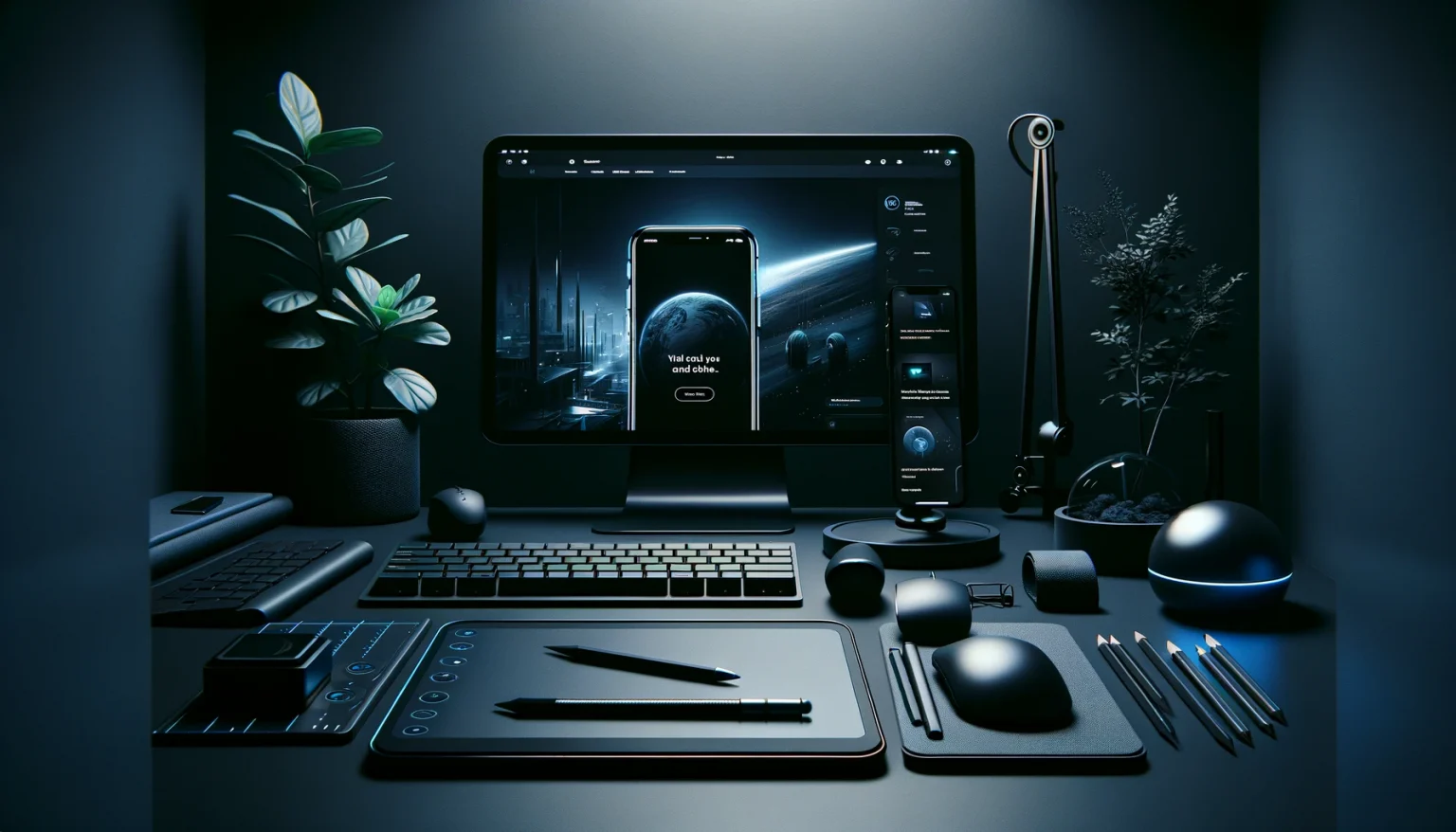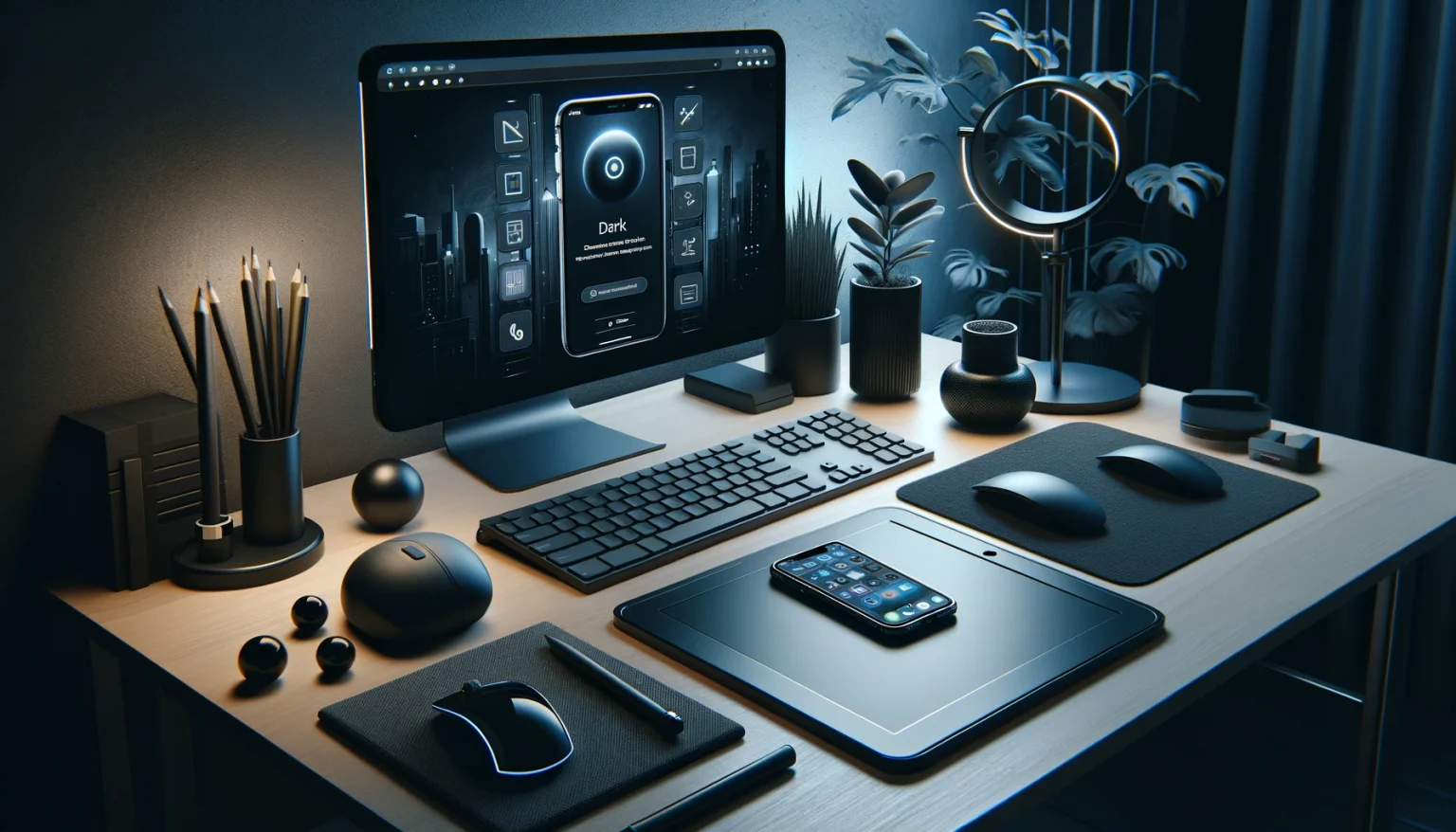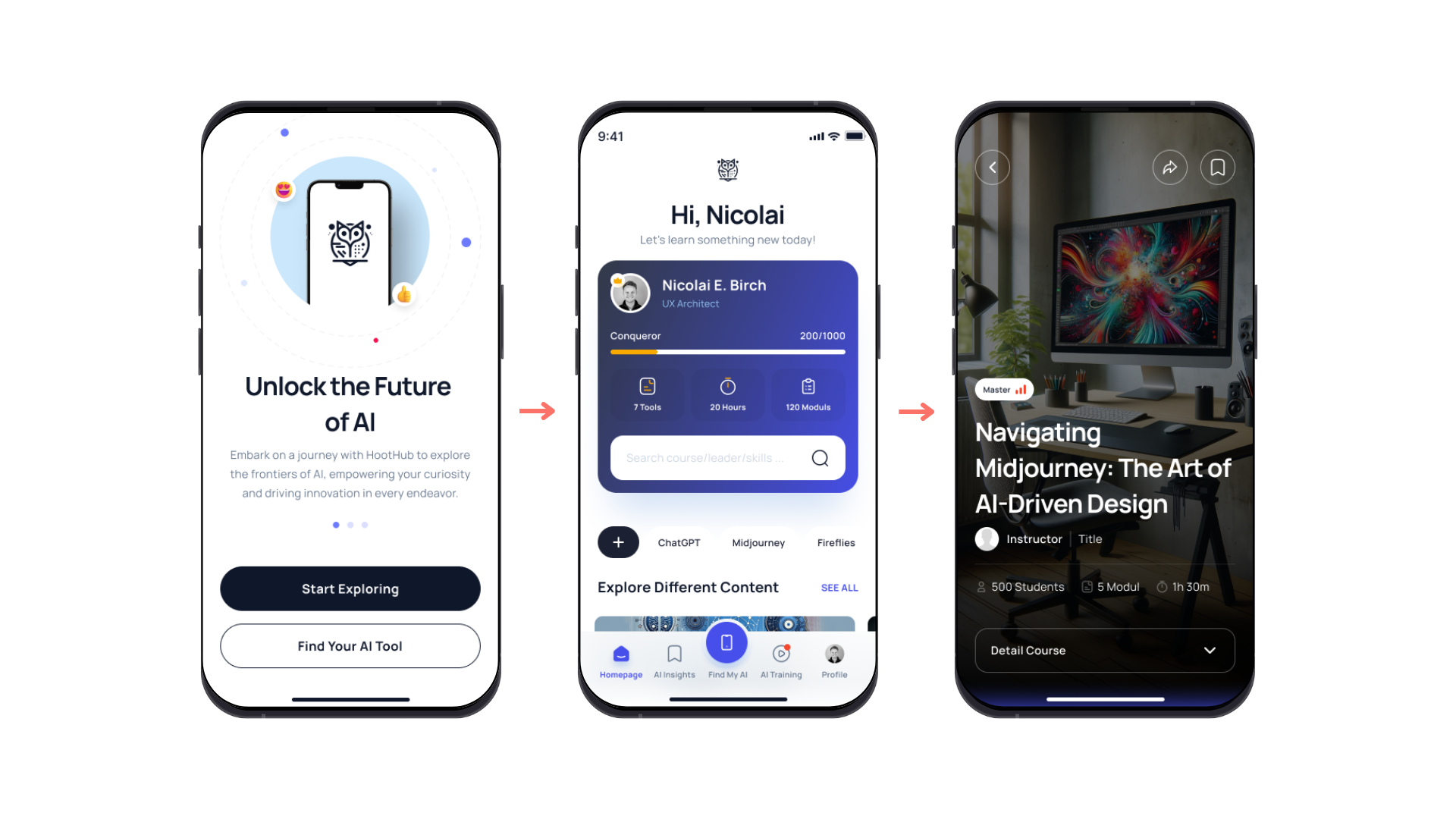Business Developer | Nicolai Errebo Birch
MOBILE APP UX DESIGN







In today’s digital landscape, creating a user-centric app is not just a luxury but a necessity. This case study delves into a fictional scenario of designing an app, emphasizing a user-centric approach. We’ll navigate through each phase of the design process, incorporating principles of user experience (UX) and user interface (UI) design, supported by scholarly research and practical methodologies. This approach aims to ensure the app is not only functional and aesthetically pleasing but also deeply resonates with its users.
Role : UX Designer
Approach : The Design Thinking Process
Client : Fictional (showcase)
Year : 2023
Category : Website
Toolkit :
Identify app user needs
Prioritize app functionalities
Set mobile UX objectives
Brainstorm app features
Explore innovative interfaces
Select viable app concepts
Create app wireframes
Develop clickable prototypes
Refine app designs
Perform app usability tests
Analyze user feedback
Optimize app UX/UI

Understanding the User in App UX Design
In the realm of app UX design, empathizing with the user is a pivotal step. This phase delves deep into understanding the target audience’s needs, behaviors, and motivations. It involves extensive user research, including interviews, surveys, and observation, to gather insights about the users. This research is not just about demographics but delves into the psychological and emotional aspects of the users, which are crucial for creating an app that resonates with them (Getto & Flanagan, 2022).
The insights gathered during this phase are instrumental in shaping the entire design process. They help in identifying the key features that the app must have and the problems it needs to solve. Understanding the user at this level ensures that the app is not just functionally robust but also emotionally engaging, a principle echoed in mobile UX design examples.
Defining the Core of App UX Design
In the ‘Define’ phase of app UX design, the gathered insights from the ‘Empathize’ phase are synthesized to form a clear problem statement. This phase is crucial in pinpointing the exact user needs and challenges that the app aims to address. According to Finn and Kuusinen (2021), in their study on AR tourist guide app development, a clear definition of user needs and goals is essential for guiding the design process. This approach ensures that the app is not only technically sound but also aligns with the users’ expectations and preferences.
A key aspect of this phase is to prioritize the user problems and needs identified during the ‘Empathize’ phase. Ahsan, Arianto, and Murdani (2020) demonstrate this in their study, where the focus was on creating a user-friendly design that meets the specific needs of its users. By defining the core problems and user goals, the design team can focus their efforts on the most critical aspects of the app.
Moreover, Convertino and Frishberg (2021) highlight the importance of incorporating user experience research in this phase to avoid mischaracterizing the target users’ needs. This is particularly relevant in agile UX software development teams, where the fast-paced environment can sometimes overlook the depth of user research required (Convertino & Frishberg, 2021).
Template Suggestion: Problem Statement and Goals Template. This template will assist in clearly articulating the main problems and goals identified during the ‘Empathize’ phase. It should include sections for defining the primary user challenges, objectives the app seeks to achieve, and how these align with the overall business strategy. This template will ensure that the app’s development is guided by a clear and focused understanding of the user needs and business objectives. By defining the core user needs and problems, the app design process becomes more targeted and effective, leading to an app that not only functions well but also resonates deeply with its users, enhancing user satisfaction and engagement.
Generating Creative Solutions for App UX Design
The ‘Ideate’ phase in app UX design is where creativity and innovation take center stage. This phase is all about generating a wide range of ideas and solutions for the app’s design, focusing on enhancing the user experience. It’s a divergent phase where quantity trumps quality, and the goal is to explore as many possibilities as possible. In this phase, designers and developers brainstorm and explore different concepts and functionalities that could enhance the app’s user experience. Techniques like mind mapping, sketching, and brainstorming sessions are commonly used. The aim is to think outside the box and come up with innovative solutions that meet user needs in unique ways.
One effective approach in this phase is the Agile Beeswax methodology, as described by Alrabaiah and Medina-Medina (2021). This methodology emphasizes an iterative process that includes idea and strategy formulation, user experience design, and user interface design. It’s particularly useful in mobile app development, where the market is highly competitive, and agile methodologies can provide value faster with higher quality and predictability.
Furthermore, the rise of “no-code” software development platforms, as explored by Liu et al. (2022), can facilitate the ideation process in app design. These platforms allow for rapid prototyping and testing of ideas, enabling designers to quickly see how their concepts would work in practice.
Template Suggestion: Idea Generation and Selection Template – This template will guide the team through the process of generating a wide array of ideas and then narrowing them down to the most viable ones. It should include sections for brainstorming, categorizing ideas, and criteria for selecting the best ideas. The template should also provide a framework for evaluating ideas based on factors like feasibility, user impact, and alignment with business goals.
Incorporating these methodologies and tools into the ideation phase can significantly enhance the creative process in app UX design. By focusing on user needs and employing agile and systematic approaches, designers can ensure that their ideas are not only innovative but also practical and user-centric.
Creating a Tangible User Experience in App Design
The Prototype phase in app UX design is a critical step where concepts and ideas are transformed into tangible experiences. This phase involves building a prototype of the app, which serves as an early version to test design concepts, user interface elements, and overall user experience. Prototyping is not about creating a finished product but about exploring and validating design decisions.
A key aspect of this phase is rapid prototyping, which allows designers to quickly develop and iterate on their ideas. This approach is essential for refining the app’s design based on real user feedback. As Tran-Nguyen et al. (2022) emphasize, involving stakeholders, including potential users, in the prototyping process ensures that the app meets actual user needs and preferences. This collaborative approach is crucial for creating an app that is not only functional but also emotionally resonant with its target audience.
In the context of mobile app UX design, the prototype should focus on core functionalities and user interactions. For instance, Henderi, Aliftiar, and Hibatullah (2021) highlight the importance of visualizing user needs in the prototype design, which can significantly enhance user experience and simplify the development process. This is particularly relevant in mobile UX design, where the user interface needs to be intuitive and accessible.
Furthermore, the prototype should be tested with a diverse group of users to gather a wide range of feedback. Mohamed Isa et al. (2023) demonstrate the value of understanding specific user groups, such as senior citizens, in enriching the user experience. This approach ensures that the app is inclusive and caters to the needs of all its users.
Usability testing during this phase is crucial. As shown in the study by Del Carmen et al. (2021), focusing on user experience, especially in apps targeting specific groups like children, can significantly impact the app’s effectiveness and user satisfaction. Testing the prototype with real users helps identify usability issues, understand user preferences, and ensure that the app aligns with user expectations.
At this point in the design process, a mid-fidelity prototype, such as the one provided in the Figma link below, becomes invaluable. This prototype represents a significant step towards the final product, showcasing the app’s basic elements and functionalities. Once tailored with specific content, colors, and texts for a real-world scenario, this prototype could feasibly be launched, marking the transition from design to deployment.
In summary, the Prototype phase is where the app starts to take shape, bridging the gap between abstract ideas and a usable product. It’s a phase of exploration, testing, and refinement, ensuring that the final app is not just a technological tool but a meaningful part of the user’s digital experience.
Refining App UX through User Feedback
The ‘Test’ phase in app UX design is crucial for refining and validating the design decisions made in earlier stages. This phase involves conducting usability tests with real users to gather feedback on the app’s functionality, aesthetics, and overall user experience. The insights gained from these tests are invaluable for making iterative improvements, ensuring the app meets the expectations and needs of its target audience. Kim & McFadden (2019) demonstrated the transformative impact of usability testing in the redesign of an enterprise mobile app. By focusing on core user tasks and a clean interface, the redesigned app significantly improved employee productivity and engagement. This case exemplifies the power of usability testing in enhancing the effectiveness and satisfaction of app users.
Chin et al. (2020) highlight the importance of aligning the app’s design with users’ mental models. In healthcare, where apps are often used for collecting process evaluation metrics, usability testing ensures the app is efficient, effective, and satisfying for users. This aligns with mobile UX design principles, emphasizing the need for an intuitive and user-friendly interface. Moeini et al.’s study on a well-being mobile app for trauma-affected communities further underscores the significance of usability testing. The study showed marked improvements in user satisfaction after UI changes were implemented, demonstrating how iterative design and user feedback are essential in mobile app UX design.
Tonga et al. (2021) provide an excellent example of user-centered design in action. Their work on a smartphone application, through iterative design and usability testing, resulted in high user satisfaction and ease of use. This case reinforces the importance of incorporating user feedback in the design process, particularly in application design for specialized user groups. In this phase, tools like A/B testing and user interviews are employed to gather quantitative and qualitative data. This data not only helps in identifying usability issues but also provides insights into user preferences and behaviors. By closely monitoring and analyzing user interactions with the app, designers can make informed decisions about which features to enhance, modify, or remove.
Step into the realm of UX innovation with my carefully crafted Figma prototypes. Each of these four flows is a testament to the blend of creativity and technological acumen, designed to showcase how UX can transform user experiences. As a dedicated practitioner in UX design, I am committed to creating solutions that not only meet but exceed user expectations. I invite you to interact with these prototypes. Your insights are crucial for driving continuous improvement and innovation. These interactive flows are more than just designs; they represent our commitment to collaboration, ethical standards, and relentless learning in the world of technology. By engaging with them, you’ll experience firsthand how we integrate user feedback to craft intuitive, effective, and aesthetically pleasing solutions.
Launching and Evolving the App
The final phase in app UX design is about bringing the mobile application to life and continuously evolving it post-launch. This stage is crucial for transitioning from a well-designed prototype to a fully functional and engaging app.
In conclusion, the implementation phase is not just about launching the app but also about strategizing for user engagement, retention, and continuous improvement. By focusing on these aspects, the app can achieve sustained success and a loyal user base.
Integrating User-Centered Design in App Development
In our exploration of app UX design, we’ve traversed from initial understanding to final implementation, each phase contributing significantly to crafting an app that’s both functional and engaging.
Beginning with the ‘Empathize’ phase, we delved into understanding the users, utilizing interviews and persona development to grasp their behaviors, needs, and motivations. This foundational phase set the stage for creating an app that truly resonates with its audience. Following this, the ‘Define’ phase helped us articulate users’ problems and needs, employing specific templates to pinpoint user expectations and challenges.
The ‘Ideate’ phase then opened a realm of creative possibilities, where brainstorming and other techniques generated diverse solutions. This phase’s creative exploration was pivotal in addressing user needs. Transitioning to the ‘Prototype’ phase, we brought these ideas to life through low and high-fidelity prototypes, allowing us to test and refine our designs effectively.
The ‘Test’ phase was instrumental in collecting user feedback, a crucial step in understanding the app’s real-world impact and making necessary adjustments for improved design and functionality. Finally, the ‘Implement’ phase marked the culmination of our efforts, where the app was not only developed technically but also strategically positioned for user engagement and retention, supported by marketing strategies and continuous optimization.
This journey underscored the importance of a user-centered approach in app UX design. By keeping the user at the forefront throughout the design process, we created an app that not only serves its functional purpose but also fosters a meaningful connection with its users, enhancing both engagement and satisfaction.
Getto, G., & Flanagan, S. (2022). Localizing UX Advocacy and Accountability: Using Personas to Amplify User Agency.
Kim, S. Y., & McFadden, E. (2019). Using Established UX Design Techniques and Visual Enhancements to Redesign an Enterprise Mobile App and Improve Employee Productivity and Engagement.
Alfaridzi, M. D., & Yulianti, L. P. (2020). UI-UX Design and Analysis of Local Medicine and Medication Mobile-based Apps using Task-Centered Design Process.
Finn, K., & Kuusinen, K. (2021). Innovation Through Universal Design in Agile UX Software Development Teams: A Collaborative Case Study of an Undergraduate AR Tourist Guide Project.
Ahsan, M., Arianto, R., & Murdani, J. (2020). User Interface Design And User Experience Kuysedekah.Id Mobile Applications.
Convertino, G., & Frishberg, N. (Year Unknown). Why Agile Teams Fail without.
Birrell, C., et al. (2022). Development of a Peer Support Mobile App and Web-Based Lesson for Adolescent Mental Health (Mind Your Mate): User-Centered Design Approach.
Alrabaiah, H. A., & Medina-Medina, N. (2021). Agile Beeswax: Mobile App Development Process and Empirical Study in Real Environment.
Aydın, A., Gürsoy, A., & Karal, H. (2023). Mobile care app development process: using the ADDIE model to manage symptoms after breast cancer surgery (step 1).
Liu, S., La, H., Willms, A., & Rhodes, R. (2022). A “No-Code” App Design Platform for Mobile Health Research: Development and Usability Study.
Chin, W., Kurowski, A., Gore, R., Chen, G., & Punnett, L. (2020). Use of a Mobile App for the Process Evaluation of an Intervention in Health Care: Development and Usability Study.
Tonga, E., Atalay, A., Kucukdeveci, A., Tennant, A., Elhan, A. H., & Kutlay, S. (2021). Development and usability testing of a smartphone application for patients with rheumatoid arthritis.
Tran-Nguyen et al. (2022). Mobile App Prototype in Older Adults for Postfracture Acute Pain Management: User-Centered Design Approach.
Henderi, Aliftiar, and Hibatullah (2021). Prototype User Interface Mobile App E-Learning.
Mohamed Isa et al. (2023). Enriching User Experience among Senior Citizens in the Digital Era: A Design-Thinking Approach to Constructing a Prototype of a Mobile Application.
Del Carmen et al. (2021). Reducing Dental Anxiety in Children Using a Mobile Health App: Usability and User Experience Study.
Loeffler, S., Roth, R., Goring, S., & Myrbo, A. (2021). Mobile UX design: learning from the Flyover Country mobile app.
Youssef, M., Mousa, S. A., Baloola, M. O., & Fouda, B. M. (2020). The Impact of Mobile Augmented Reality Design Implementation on User Engagement.
Young, S., Lattie, E., Berry, A. B. L., Bui, L., Byrne, G. J., Benavente, J. Y., Bass, M. B., Gershon, R., Wolf, M., & Nowinski, C. (2022). Remote Cognitive Screening Of Healthy Older Adults for Primary Care With the MyCog Mobile App.

